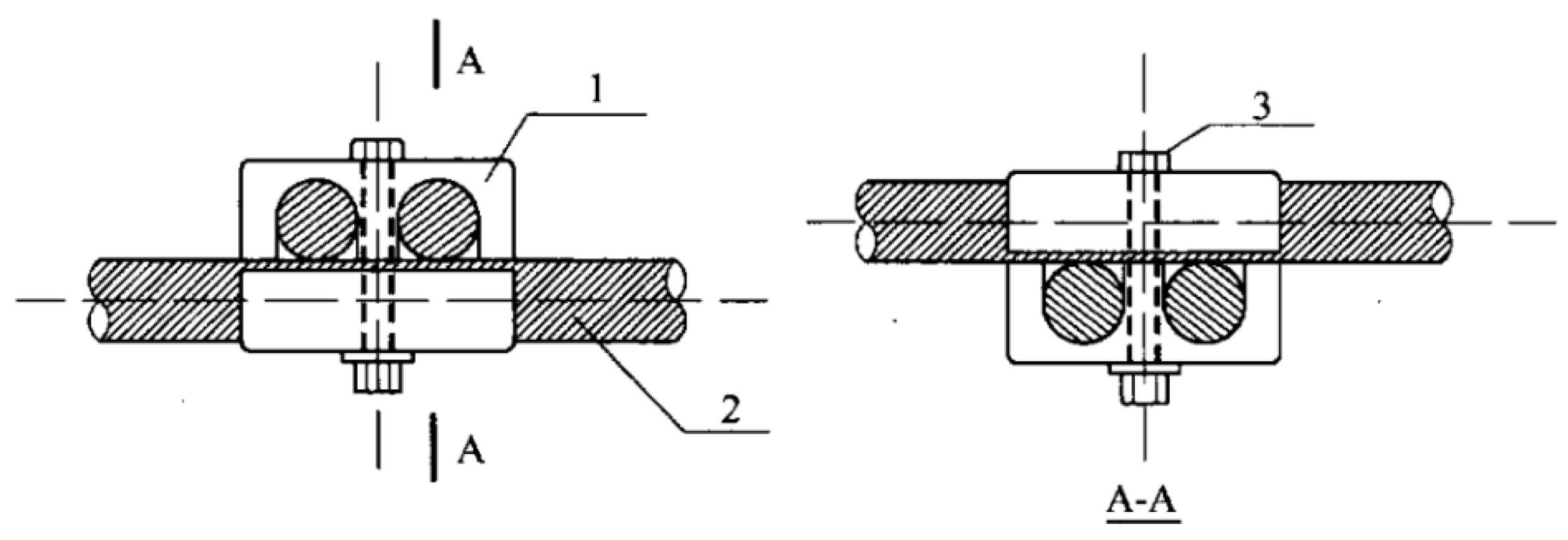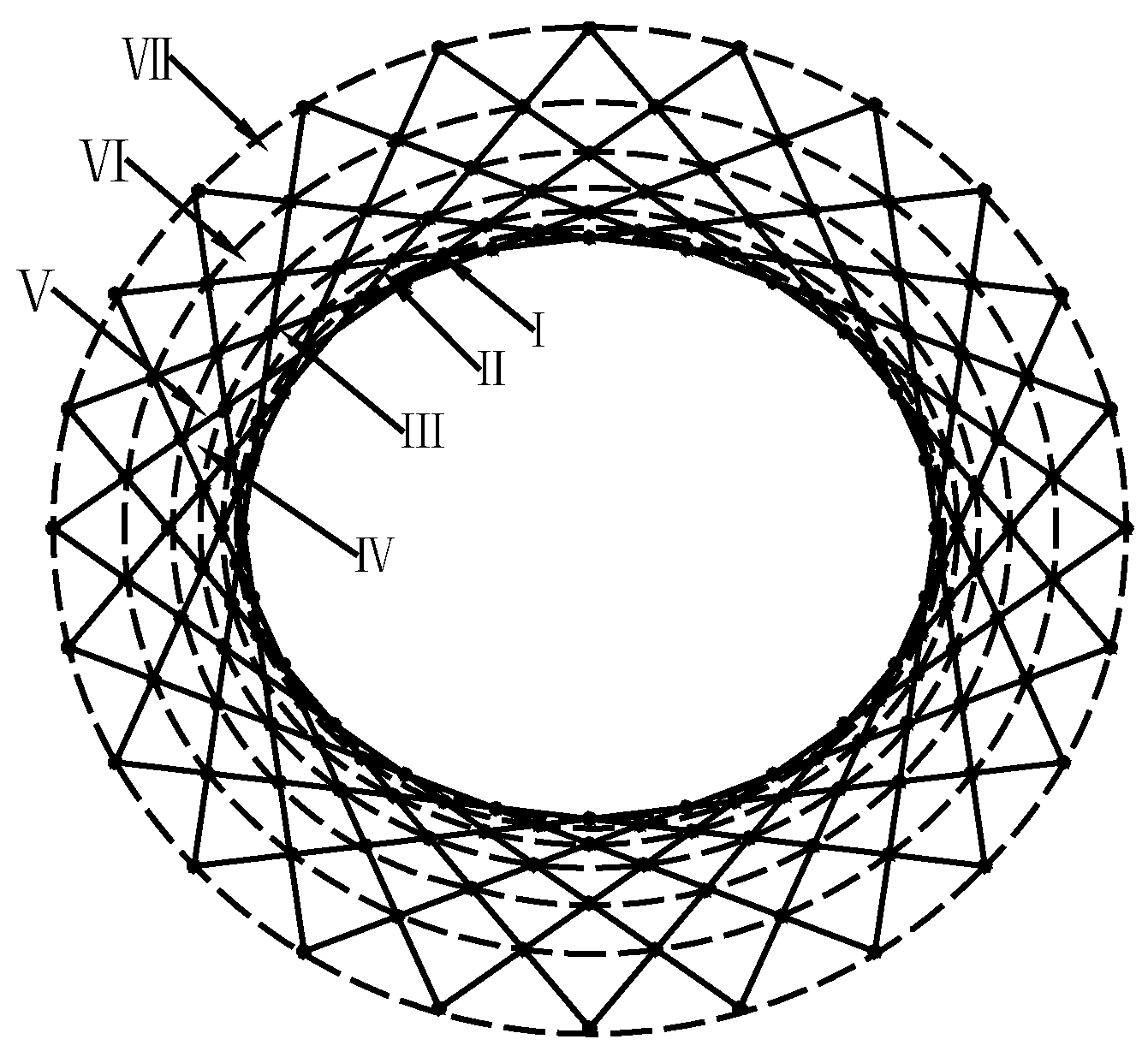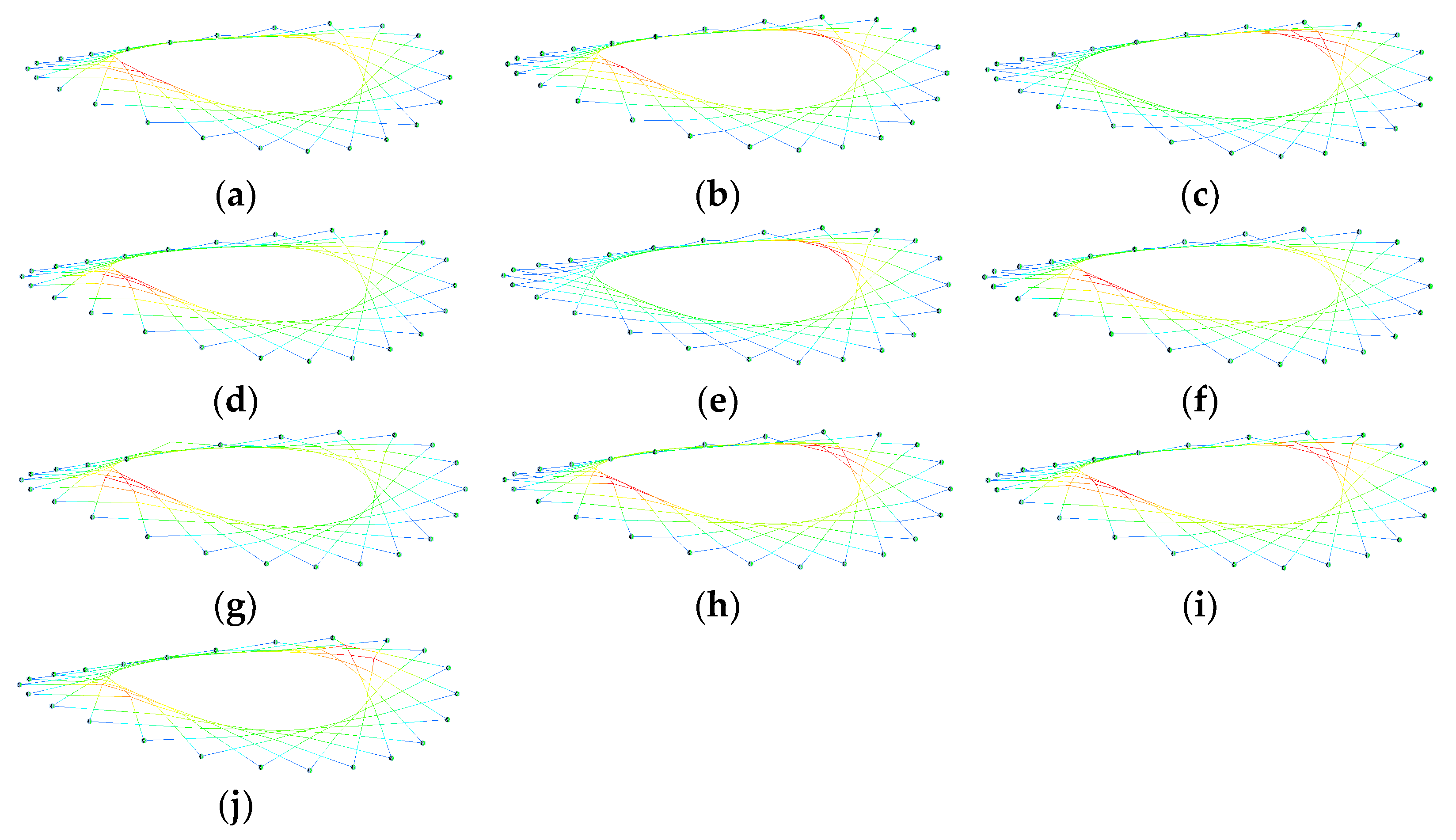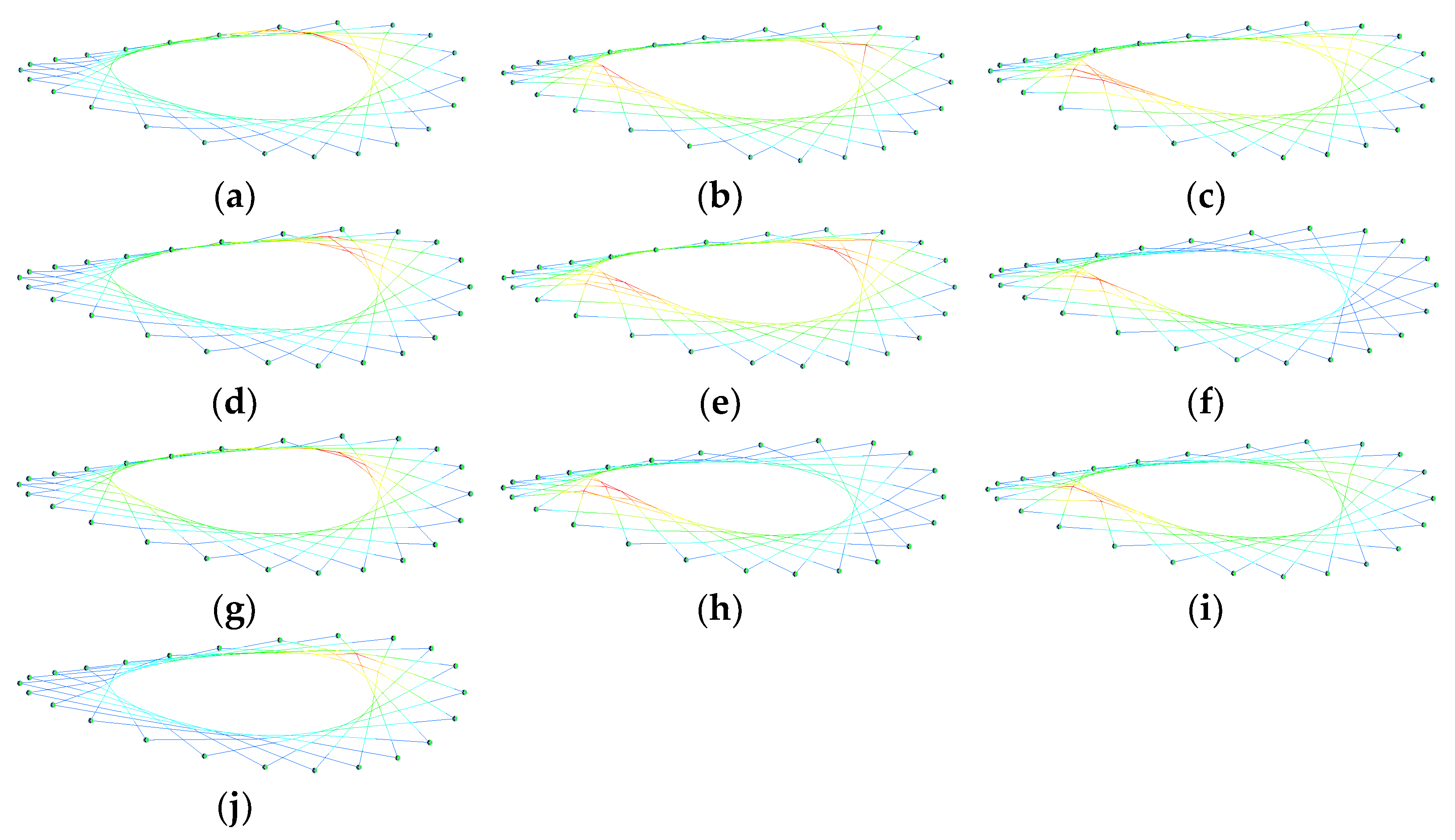Effect of Clamp Deletion on Static Behavior and Dynamic Characteristics of Loop-Free Cable Net Structures
Abstract
:1. Introduction
2. Analysis Models and Methods
2.1. Engineering Background
2.2. Structural Design of the Model
2.2.1. Materials and Components
2.2.2. Load Combinations
2.2.3. Validation of the Model
2.3. Cable Clamp Deletion Schemes
3. Results
3.1. Deleting One Virtual Ring
3.2. Deleting Two Virtual Rings
3.3. Deleting Three Virtual Rings
3.4. Deleting Four or Five Virtual Rings
4. Conclusions
Author Contributions
Funding
Data Availability Statement
Conflicts of Interest
References
- Xue, S.D. Tension structures in China. J. Int. Assoc. Shell Spat. Struct. 2006, 47, 125–134. [Google Scholar]
- Krishna, P. Tension roofs and bridges. J. Constr. Steel Res. 2001, 57, 1123–1140. [Google Scholar] [CrossRef]
- Yu, Y.J.; Wu, J.Z.; Chen, Z.H. The beginning of modern tension-hung roofs: Dorton Arena. Spat. Struct. 2016, 22, 50–58. [Google Scholar] [CrossRef]
- Quelle, I.G. Cable roofs. Evolution, Classification and Future Trends. In Proceedings of the IASS Symposium, Universidad Politecnica de Valencia, Valencia, Spain, 28 September–2 October 2009. [Google Scholar]
- Ministry of Housing and Urban-Rural Development of the People’s Republic of China. Technical Specification for Cable Structures; JGJ 257-2012; China Architecture and Building Press: Beijing, China, 2012. [Google Scholar]
- Krishnan, S. Structural design and behavior of prestressed cable domes. Eng. Struct. 2020, 209, 110294. [Google Scholar] [CrossRef]
- Liu, R.J.; Li, X.Y.; Xue, S.D.; Mollaert, M.; Ye, J.H. Numerical and experimental research on annular crossed cable-truss structure under cable rupture. Earthq. Eng. Eng. Vib. 2017, 16, 557–569. [Google Scholar] [CrossRef]
- Boom, I. Tensile-Compression Ring: A Study for Football Roof Structures. Master Thesis, University of Technology Delft, Rotterdam, The Netherlands, 2012. [Google Scholar]
- Ma, S.; Lu, K.; Chen, M.H.; Skelton, R.E. Design and control analysis of a deployable clustered hyperbolic paraboloid cable net. Eng. Struct. 2023, 279, 115569. [Google Scholar] [CrossRef]
- Liu, R.J.; Zou, Y.; Wang, G.Y.; Xue, S.D. On the collapse resistance of the levy type and the loop-free suspen-dome structures after accidental failure of cables. Int. J. Steel Struct. 2022, 22, 585–596. [Google Scholar] [CrossRef]
- Liu, R.J.; Xue, S.D.; Sun, G.J.; Li, X.Y. Formulas for the derivation of node coordinates of annular crossed cable-truss structure in a pre-stressed state. J. Int. Assoc. Shell Spat. Struct. 2014, 55, 223–228. [Google Scholar]
- Liu, R.J.; Xue, S.D.; Li, X.Y.; Mollaert, M.; Sun, G.J. Preventing disproportionate displacements in an annular crossed cable-truss structure. Int. J. Spat. Struct. 2017, 32, 3–10. [Google Scholar] [CrossRef]
- Liu, R.J.; Li, M.Q.; Cheng, T.C. Discussion on cable-strut systems of the suspen-dome structures. Int. J. Spat. Struct. 2022, 38, 20–29. [Google Scholar] [CrossRef]
- Xue, S.D.; Liu, R.J.; Li, X.Y.; Zou, Y.; Liu, Y. Innovation of non-loops cable-supported structures. Spat. Struct. 2020, 26, 15–22. [Google Scholar] [CrossRef]
- Liu, R.J.; Xue, S.D.; Li, X.Y. Static behavior analysis for annular crossed cable-truss structures. Spat. Struct. 2014, 20, 89–96. [Google Scholar] [CrossRef]
- Xue, S.D.; Tian, X.S.; Liu, Y.; Li, X.Y.; Liu, R.J. Mechanical behavior of single-layer saddle-shape crossed cable net without inner-ring. J. Build. Struct. 2021, 42, 30–38. [Google Scholar] [CrossRef]
- Liu, R.J.; Wang, C.; Xue, S.D.; Zou, Y. Analysis on the collapse resistance of the loop-free suspen-dome subjected to cable or strut failure. J. Int. Assoc. Shell Spat. Struct. 2022, 63, 5–15. [Google Scholar] [CrossRef]
- Liu, R.J.; Xue, S.D.; Cao, J.J.; Li, X.Y.; Liu, Y. Analysis on single-layer hyperbolic cable net structure schemes of stadium roof. J. Build. Struct. 2022, 43, 269–276. [Google Scholar] [CrossRef]
- Lu, J.; Xue, S.D.; Li, X.Y. Analysis on mechanical performance of ellipse cable-net structure without inner ring cables. J. Southeast Univ. (Nat. Sci. Ed.) 2021, 51, 783–789. [Google Scholar] [CrossRef]
- Ministry of Housing and Urban-Rural Development of the People’s Republic of China. Load Code for the Design of Building Structures; GB 50009-2012; China Architecture and Building Press: Beijing, China, 2012. [Google Scholar]
- Ministry of Housing and Urban-Rural Development of the People’s Republic of China. The Technical Regulations for Cable Structures; JGJ 257-2012; China Architecture and Building Press: Beijing, China, 2012. [Google Scholar]
- Ministry of Housing and Urban-Rural Development of the People’s Republic of China. Unified Standard for Reliability Design of Building Structures; GB50068-2018; China Architecture and Building Press: Beijing, China, 2018. [Google Scholar]
- Schek, H.J. The force density method for form finding and computation of general networks. Comput. Methods Appl. Mech. Eng. 1974, 3, 115–134. [Google Scholar] [CrossRef]
- Barnes, M.R. Form finding and analysis of tension structures by dynamic relaxation. Int. J. Space Struct. 1999, 14, 89–104. [Google Scholar] [CrossRef]
- Argyris, J.H.; Angelopoulos, T.; Bichat, B. A general method for the shape finding of lightweight tension structures. Comput. Methods Appl. Mech. Eng. 1974, 3, 135–149. [Google Scholar] [CrossRef]
- Xiang, Y.; Luo, Y.F.; Guo, X.N.; Xiong, Z.; Shen, Z.Y. A linearized approach for the seismic response analysis of flexible cable net structures. Soil Dynam. Earthq. Eng. 2016, 88, 92–108. [Google Scholar] [CrossRef] [Green Version]
- Singhal, D.; Narayanamurthy, V. Large and small deflection analysis of a cantilever beam. J. Inst. Eng. (India) Series A 2019, 100, 83–96. [Google Scholar] [CrossRef]
- Nour-Omid, B. Applications of the Lanczos method. Comput. Phys. Commun. 1989, 53, 157–168. [Google Scholar] [CrossRef]
- Zhu, M.L.; Luo, B.; Guo, Z.X. Analysis and Construction of Cable Net Structure of Suzhou Olympic Sports Center; China Architecture and Building Press: Beijing, China, 2018; pp. 106–111. [Google Scholar]











| Numbers | Load Combination Expressions |
|---|---|
| LCB1 | D + P + S |
| LCB2 | D + P + W |
| LCB3 | D + P+S+0.6 W |
| LCB4 | D + P + 0.7 S + 1.0 W |
| LCB5 | 1.3 D + 1.3 P + 1.5 S |
| LCB6 | 1.3 D + 1.3 P + 1.5 W |
| LCB7 | 1.3 D + 1.3 P + 1.5 W + (1.5 × 0.7) S |
| LCB8 | 1.3 D + 1.3 P + 1.5 S + (1.5 × 0.6) W |
| No. | Virtual Ring | No. | Virtual Rings | No. | Virtual Rings | No. | Virtual Rings |
|---|---|---|---|---|---|---|---|
| SE1/1 | II | SE2/4 | II, VI | SE3/2 | II, III, V | SE3/10 | IV, V, VI |
| SE1/2 | III | SE2/5 | III, IV | SE3/3 | II, III, VI | SE4/1 | II, III, IV, V |
| SE1/3 | IV | SE2/6 | III, V | SE3/4 | II, IV, V | SE4/2 | II, III, IV, VI |
| SE1/4 | V | SE2/7 | III, VI | SE3/5 | II, IV, VI | SE4/3 | II, III, V, VI |
| SE1/5 | VI | SE2/8 | IV, V | SE3/6 | II, V, VI | SE4/4 | II, IV, V, VI |
| SE2/1 | II, III | SE2/9 | IV, VI | SE3/7 | III, IV, V | SE4/5 | III, IV, V, VI |
| SE2/2 | II, IV | SE2/10 | V, VI | SE3/8 | III, IV, VI | SE5/1 | II, III, IV, V, VI |
| SE2/3 | II, V | SE3/1 | II, III, IV | SE3/9 | III, V, VI |
| Scheme | DP1/m | PDP2/% | MT3/kN | PMT4/% | T/s | PT5/% |
|---|---|---|---|---|---|---|
| SE0 | −0.932 | -- | 1.14 × 104 | -- | 1.866 | -- |
| SE1/1 | −1.330 | 42.70 | 1.21 × 104 | 6.09 | 2.152 | 15.33 |
| SE1/2 | −1.472 | 57.85 | 1.25 × 104 | 9.87 | 2.075 | 11.18 |
| SE1/3 | −1.532 | 64.32 | 1.26 × 104 | 10.23 | 2.096 | 12.35 |
| SE1/4 | −1.273 | 36.48 | 1.29 × 104 | 13.14 | 2.396 | 28.40 |
| SE1/5 | −1.362 | 46.11 | 1.26 × 104 | 10.39 | 2.244 | 20.24 |
| Scheme | DP/m | PDP/% | MT/kN | PMT/% | T/s | PT/% |
|---|---|---|---|---|---|---|
| SE2/1 | −1.462 | 56.82 | 1.20 × 104 | 5.11 | 2.074 | 11.17 |
| SE2/2 | −1.639 | 75.78 | 1.26 × 104 | 10.60 | 2.080 | 11.48 |
| SE2/3 | −1.854 | 98.85 | 1.36 × 104 | 19.12 | 2.222 | 19.07 |
| SE2/4 | −1.659 | 77.95 | 1.30 × 104 | 14.07 | 2.178 | 16.69 |
| SE2/5 | −1.968 | 111.14 | 1.28 × 104 | 12.03 | 2.206 | 18.24 |
| SE2/6 | −1.675 | 79.73 | 1.31 × 104 | 14.80 | 2.151 | 15.29 |
| SE2/7 | −1.682 | 80.41 | 1.32 × 104 | 16.00 | 2.217 | 18.83 |
| SE2/8 | −1.920 | 105.91 | 1.34 × 104 | 17.89 | 2.285 | 22.43 |
| SE2/9 | −2.095 | 124.68 | 1.37 × 104 | 20.53 | 2.332 | 24.99 |
| SE2/10 | −1.888 | 102.52 | 1.40 × 104 | 22.71 | 2.378 | 27.45 |
| Scheme | DP/m | PDP/% | MT/kN | PMT/% | T/s | PT/% |
|---|---|---|---|---|---|---|
| SE3/1 | −1.754 | 88.13 | 1.32 × 104 | 15.97 | 2.270 | 21.64 |
| SE3/2 | −2.000 | 114.53 | 1.33 × 104 | 16.26 | 2.226 | 19.31 |
| SE3/3 | −2.384 | 155.75 | 1.37 × 104 | 20.17 | 2.402 | 28.72 |
| SE3/4 | −2.309 | 147.72 | 1.46 × 104 | 27.98 | 2.410 | 29.15 |
| SE3/5 | −2.045 | 119.36 | 1.35 × 104 | 18.45 | 2.324 | 24.57 |
| SE3/6 | −2.896 | 210.68 | 1.49 × 104 | 30.59 | 2.616 | 40.17 |
| SE3/7 | −2.622 | 181.27 | 1.40 × 104 | 22.53 | 2.538 | 36.01 |
| SE3/8 | −2.393 | 156.68 | 1.34 × 104 | 17.83 | 2.3639 | 26.68 |
| SE3/9 | −2.146 | 130.18 | 1.44 × 104 | 26.69 | 2.469 | 32.30 |
| SE3/10 | −3.835 | 311.34 | 1.57 × 104 | 38.07 | 2.9956 | 60.54 |
| Scheme | DP/m | PDP/% | MT/kN | PMT/% | T/s | PT/% |
|---|---|---|---|---|---|---|
| SE4/1 | −2.615 | 180.50 | 1.36 × 104 | 19.28 | 2.652 | 42.14 |
| SE4/2 | −3.171 | 240.09 | 1.45 × 104 | 27.10 | 2.610 | 39.89 |
| SE4/3 | −3.835 | 311.34 | 1.57 × 104 | 38.07 | 2.945 | 57.82 |
| SE4/4 | −4.306 | 361.83 | 1.77 × 104 | 55.59 | 3.083 | 65.20 |
| SE4/5 | −6.111 | 555.40 | 2.20 × 104 | 92.70 | 3.999 | 114.33 |
| SE5/1 | −6.556 | 603.10 | 1.74 × 104 | 52.75 | 4.316 | 131.30 |
Disclaimer/Publisher’s Note: The statements, opinions and data contained in all publications are solely those of the individual author(s) and contributor(s) and not of MDPI and/or the editor(s). MDPI and/or the editor(s) disclaim responsibility for any injury to people or property resulting from any ideas, methods, instructions or products referred to in the content. |
© 2023 by the authors. Licensee MDPI, Basel, Switzerland. This article is an open access article distributed under the terms and conditions of the Creative Commons Attribution (CC BY) license (https://creativecommons.org/licenses/by/4.0/).
Share and Cite
Liu, R.; Cao, J.; Wang, G. Effect of Clamp Deletion on Static Behavior and Dynamic Characteristics of Loop-Free Cable Net Structures. Buildings 2023, 13, 881. https://doi.org/10.3390/buildings13040881
Liu R, Cao J, Wang G. Effect of Clamp Deletion on Static Behavior and Dynamic Characteristics of Loop-Free Cable Net Structures. Buildings. 2023; 13(4):881. https://doi.org/10.3390/buildings13040881
Chicago/Turabian StyleLiu, Renjie, Jiajia Cao, and Guangyong Wang. 2023. "Effect of Clamp Deletion on Static Behavior and Dynamic Characteristics of Loop-Free Cable Net Structures" Buildings 13, no. 4: 881. https://doi.org/10.3390/buildings13040881
APA StyleLiu, R., Cao, J., & Wang, G. (2023). Effect of Clamp Deletion on Static Behavior and Dynamic Characteristics of Loop-Free Cable Net Structures. Buildings, 13(4), 881. https://doi.org/10.3390/buildings13040881






